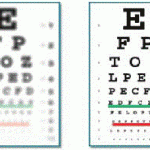Wavefront Technology and LASIK
Submitted by Dr. Dean Dornic on Sun 09/02/2012 - 12:42

Optical aberrations can effect the quality of vision after LASIK
Early in the history of LASIK eye surgery, a small sub-group of patients complained about the quality of their vision. Some actually had 20/20 levels of vision but described issues of “vision not being crisp” or “poor contrast”. Some complained of disturbed night vision: star-bursting or halos around lights. Out of a desire to solve these patients complaints, the science of wave-front guided LASIK science was born.
A standard LASIK procedure is based solely on a patient’s eyeglass prescription. A wavefront-guided LASIK is a treatment based on all of the eye’s measured optical aberrations. These aberrations are measured with a sophisticated device called a wavefront-analyzer, which essentially takes a “fingerprint” of the eye. This unique “fingerprint” is then recorded and used to correct vision with a sophisticated, computer-controlled laser.
But the use of a wavefront-analyzer to perform LASIK added time and cost to the procedure. A “shortcut” was developed to reduce time and cost: the wavefront-optimized LASIK procedure. An “optimized” LASIK procedure was designed to be aberration-neutral, neither creating nor reducing aberrations. The treatment is still based on the refractive prescription in glasses. It does not measure and cannot correct optical aberrations in the eye.

New aberrations created from standard LASIK can cause “starbursting” at night. Wavefront-guided LASIK can minimize or eliminate starbursting.
A wavefront-optimized procedure is better than a standard LASIK procedure because it tends to reduce the incidence and severity of new aberrations. A wavefront-guide procedure is even better than a wavefront-optimized procedure because it actually measures and treats pre-existing higher-order aberrations Wavefront-guided LASIK procedures, just like optimized, can minimize induction of spherical aberrations. But it can also measure and treat other higher-order aberrations.
There is no disputing that wavefront-guided LASIK uses much higher technology and is more expensive than standard or wavefront-optimized LASIK. But the real advantage of a wavefront-guided LASIK is more than just higher technology. Studies have demonstrated that a wavefront-guided LASIK results in better outcomes and better visual quality — especially when it comes to vision at night or in a dark environment, or when there is a high visual demand.
A wavefront-optimized LASIK procedure tends to reduce the incidence of visual side-effects as compared to standard LASIK but for the ultimate in outcomes, choose a wavefront-guided LASIK procedure.
